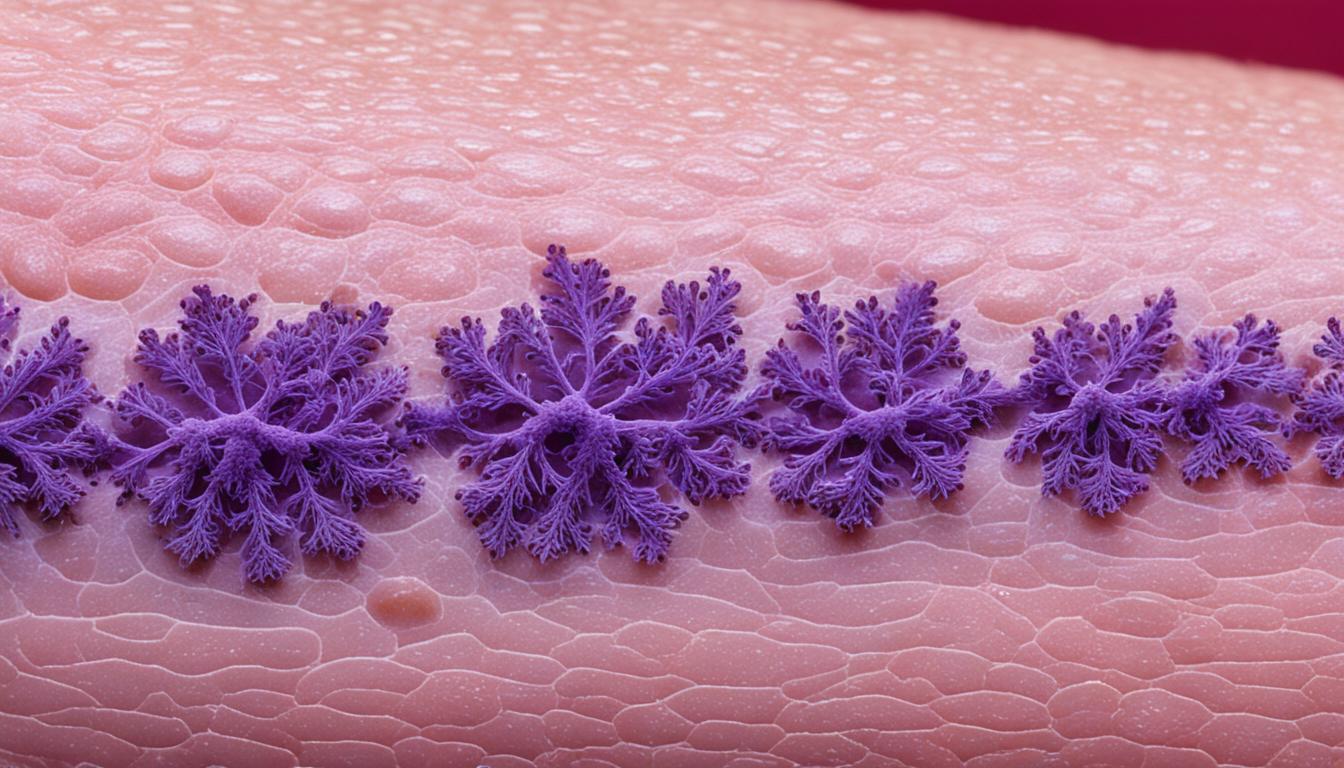Lichen planus is a skin problem that leads to a rash in different body areas. These include the skin, mouth, scalp, nails, and private parts. It can affect both genders, with women usually getting it in their 60s and men in their 40s. Even though it’s not an autoimmune issue, it acts like one, causing the body to fight itself. Its true cause is not fully understood, but it looks like the immune system reacts to a protein found in skin and mucus membranes.
This condition shows up as itchy, purple, flat-topped areas on the skin. When it’s in the mouth, it can look like white dots, eventually turning into sores or redness. People may also feel like their skin is thinning, very itchy, or see scars forming. Doctors diagnose it by looking at the symptoms and, sometimes, doing a biopsy.
The reasons behind lichen planus are not crystal clear. But things like genetics, viral infections (like hepatitis C), certain medicines, skin irritants, and even changes in the mouth’s bacterial community could be involved. There are good ways to treat it, such as using creams, taking medicine by mouth, or using special lights. If it’s really bad or not getting better, using stem cells could be a new and good option.
Key Takeaways:
- Lichen planus is a skin condition that can affect various parts of the body, including the skin, mouth, scalp, nails, and genitals.
- It is not an autoimmune condition but can trigger a similar immune response.
- Women are more likely to develop lichen planus in their 60s, while men are more commonly affected in their 40s.
- Symptoms include pruritic, purple, flat-topped skin lesions, and white dots inside the mouth.
- Diagnosis is often based on clinical presentation and may require a biopsy.
- The exact cause of lichen planus is still unknown, but genetic factors, viral infections, certain drugs, contact allergens, and oral microbiome changes are believed to play a role.
- Treatment options include topical corticosteroids, oral medications, and phototherapy.
- For severe or refractory cases, stem cell therapy shows promise as an alternative treatment.
What is Lichen Planus and What are its Symptoms?
Lichen planus is a disease that causes inflammation on skin, mucous membranes, hair, and nails. It leads to pruritic, purple, polygonal, flat-topped papules on the skin. In the mouth, it shows as white dots that can turn into sores. You might also notice skin getting thinner, feeling itchy, and scars forming from this condition. The skin problems can vary from small dots to big plaques.
Doctors diagnose lichen planus by looking at how it appears. Sometimes they might need to do a small surgery to be sure.
Common Symptoms of Lichen Planus
| Symptoms | Description |
|---|---|
| Skin lesions | Pruritic, purple, polygonal, flat-topped papules |
| Oral lichen planus | White dots on the inside of the cheeks or tongue, may progress to sores |
| Thinning of the skin | Loss of thickness in affected areas |
| Itchiness | Uncomfortable sensation that triggers scratching |
| Scarring | Development of permanent skin marks |
What are the Causes and Diagnosis of Lichen Planus?
Lichen planus is a skin condition that puzzles many. It appears to be linked to an immune response against skin and mucous membrane proteins. This response is not like typical autoimmune diseases but acts similarly.
Several things may lead to lichen planus. This includes your genes, having hepatitis C, some drugs, touching things that cause allergies, and changes in the mouth’s bacteria. Combined, these factors might make lichen planus happen, but they affect people differently.
Doctors diagnose lichen planus by what they see and sometimes by taking a small skin or mouth tissue sample. They look for the condition’s telltale signs, like purplish, flat-topped bumps or white sores in the mouth. Sometimes, a biopsy is essential for a clear diagnosis. It involves taking a small piece of the skin or mouth tissue to look at under a microscope.
Looking at the skin with a special technique called immunofluorescence can also help diagnose lichen planus. This method helps find specific markers in the skin, which aids in identifying the condition. It’s particularly useful when trying to rule out other similar skin problems.
Identifying lichen planus early is key to treating it effectively. Dermatologists and oral medicine specialists are skilled at diagnosis and providing suitable treatment. They can offer the best care for those with lichen planus.
| Common Causes of Lichen Planus | |
|---|---|
| Genetic factors | Inherited predisposition to lichen planus |
| Viral infections | Hepatitis C and other viral infections as triggers |
| Certain medications | Drugs that may induce lichen planus as a side effect |
| Contact allergens | Allergic reactions to substances that come into contact with the skin |
| Changes in the oral microbiome | Alterations in the oral bacterial composition |
Stem Cell Therapy for Lichen Planus
Stem cell therapy is becoming a new and innovative treatment for lichen planus. This method uses the power of stem cells to fix damaged tissues. Stem cells can change into various cell types, offering hope for conditions like lichen planus.
Early studies show that using stem cells can help with lichen planus. People who’ve tried it say their symptoms got better and their skin healed more. But, we need more research to fully understand the benefits and risks of this treatment.
If you’ve not had much luck with common treatments or your lichen planus is severe, consider stem cell therapy. It could bring new hope and better results for tackling this difficult condition.

